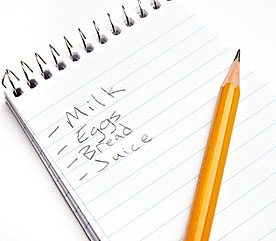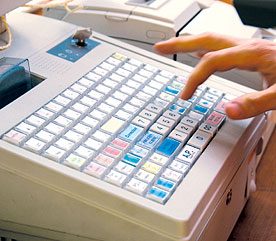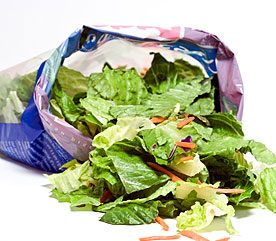
1. Go Food Shopping Once a Week
If you’re hooked on impromptu food shopping, break that expensive habit right now. Attach a magnet-backed notepad and pen to your refrigerator, and the moment a food container runs empty and you need to replace it, add it to your list. This simple discipline will have a major impact on your family budget. When you don’t keep a list, you’re likely to drop into the store for one item here, and two items there. Instead, establish a time each week that you can go to the store when you have time to focus on your shopping and you aren’t in a rush. Be sure to take your list with you on your way out the door.
Supermarket managers love it when you don’t keep a list, for several reasons. First, the more times you go into the store, the more chances you’ll have of picking up unnecessary items on impulse. Also, when you buy goods on the spur of the moment, you’re more likely to pay full price for them, since you didn’t have time to look for a sale or wait for one to arrive. In addition, the more trips you make to the store, the more gas you burn, which adds an invisible cost to your groceries.

2. Only Use a Shopping Cart When Absolutely Necessary
If you’re going to the supermarket to buy only one item, refrain from getting a basket. If you’re only buying three items, get a basket, not a cart. Only get a cart if you’re picking up a bunch of items. When you venture into the store knowing you’re going to have to carry your purchases up to the counter, you probably won’t make impulse buys. Since you’ve already scouted out the bargains in the sales ads and made a list of the items you need, you shouldn’t be buying more stuff anyway, right?

3. Know Prices of One Dozen Products
Buy a small spiral-bound notebook, and look through your refrigerator, freezer, and pantry for the 12 products you buy most often. For many people, this list will include sodas, milk, juice, and bread. Give each item its own page and write its name at the top of the page. Take your notebook to the store whenever you shop, and each time you buy the item, jot down the price. And each time you see the item listed in a supermarket sale circular, note the price in your notebook too.
It won’t take long for you to become aware of when you should stock up on bargains and when you should wait for a sale. As savvy shoppers have learned through their adventures in bargain-finding, you have to know the difference between great prices and expensive markups in order to save money.
Although a large supermarket may contain 30,000 items, just being able to find your top 12 items at a discount will save you big money. One frugality expert shared this information with us: By simply stocking up on chicken breasts only when they’re on sale – rather than paying the going price every week – she saves $325 every year.

4. Watch the Register
The checker at the supermarket will want to discuss the weather or make other small talk with you as she rings up your purchases. She may or may not have been trained to do that to help the store make more money from you, but either way, this distraction can certainly do it. Politely respond that you need to pay attention to something else instead – and keep your eyes trained like a hawk on the register readout.
Cash registers aren’t always updated with the latest sale prices on items, and some stores pledge to give customers an item free if the register rings up the wrong price. Since you’ve done your homework and know exactly how much the items should cost, alert the clerk if any wrong prices come up. If the store has a generous mistake-finding policy, your moment of attention has earned you a free item. But even if you don’t get the product free, at the very least you’re ensured that you’re getting the low price that you took the time to find.

5. Check Your Discount Card Carefully
Many supermarkets offer discount cards so you can save money on certain products. Often these cards come in the form of tiny plastic rectangles that go on your key chain, which the clerk passes over the register scanner. Be careful when you hand your key chain to the clerk if more than one store’s discount card is attached to it. If the clerk scans the wrong card, the machine may still beep as if it’s going to give you the discount – but it never does. Hold the right card between your fingertips as you hand your key chain over at the checkout counter, and watch the register to make sure that it’s displaying your discounts.

6. Do it Yourself to Save Money
Food companies like you to think they’re doing you a favor by offering bags of prewashed salad and individual servings of soup. Actually, they’re just looking for a way to charge you more money. Buy individual salad components instead of bagged salads, and soup, oatmeal, cereal, and other foods in regular-sized containers instead of tiny ones. Washing the salad or dividing the food into multiple bowls only takes a few seconds, and you won’t be paying extra money for conveniences that you don’t really need.